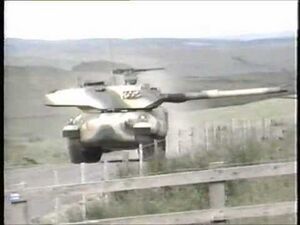PaVå-35: Difference between revisions
No edit summary |
No edit summary |
||
| Line 29: | Line 29: | ||
|armour= {{wpl|Aluminium|Welded Aluminium}} | |armour= {{wpl|Aluminium|Welded Aluminium}} | ||
|primary_armament= 1 x [[Alban Arsenal]] {{wpl|Royal_Ordnance_L7|GHC-11}} 105mm L/52 rifled cannon | |primary_armament= 1 x [[Alban Arsenal]] {{wpl|Royal_Ordnance_L7|GHC-11}} 105mm L/52 rifled cannon | ||
|secondary_armament= 2 x {{wpl| | |secondary_armament= 2 x {{wpl|L94A1_chain_gun|GAM-24}} coaxial machine gun | ||
|engine= 9.0L V6 turbo-diesel engine | |engine= 9.0L V6 turbo-diesel engine | ||
|engine_power= 552 hp | |engine_power= 552 hp | ||
Revision as of 02:38, 2 August 2019
This article is incomplete because it is pending further input from participants, or it is a work-in-progress by one author. Please comment on this article's talk page to share your input, comments and questions. Note: To contribute to this article, you may need to seek help from the author(s) of this page. |
| TAG-35 | |
|---|---|
 | |
| Type | Airborne Light tank |
| Place of origin | |
| Service history | |
| Used by | |
| Production history | |
| Designer | Global Defense Land Systems |
| Designed | 1984-1989 |
| Manufacturer | Global Defense Land Systems |
| Produced | 1991-Present |
| Specifications | |
| Weight | 19.8 tonnes (21.8 short tons; 19.5 long tons) |
| Length | 8.61 metres (28 ft 3 in) gun forward |
| Width | 2.69 metres (8 ft 10 in) |
| Height | 2.35 metres (7 ft 9 in) |
| Crew | 4 (commander, gunner, loader, driver) |
| Armor | Welded Aluminium |
Main armament | 1 x Alban Arsenal GHC-11 105mm L/52 rifled cannon |
Secondary armament | 2 x GAM-24 coaxial machine gun |
| Engine | 9.0L V6 turbo-diesel engine 552 hp |
| Power/weight | 28 hp/tonne |
| Suspension | torsion bar |
| Ground clearance | 410 millimetres (1 ft 4 in) |
| Fuel capacity | 570 L (150 US gal) |
Operational range | 483 km (300 mi) |
| Speed | 70 km/h (43 mph) |
The TAG-35 is a Trinovantan airborne light tank designed and produced by Global Defense Land Systems to supplement the TAG-26 in Trinovantan rapid deployment forces.
Development
In the early 1980s, the Trinovantan Army was convinced of the need of a heavier air-transportable fire support vehicle for use in rapid deployment forces. At the time, airborne forces could only rely on the TAG-26 and other variants of the Universal Light Chassis for this role, and the aging 8 tonne platform was deemed to be insufficiently armed and armored for direct fire support against hardened targets in the modern era.
{wip}
Design
Armament
It’s an L7 lmao
Protection
Not much
Mobility
Vroom vroom
Sensors and Systems
It’s got good seeing glass
Operational History
>implying
